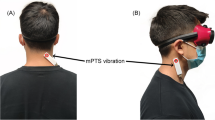Abstract
The present investigation evaluated the effects of changes in pelvic orientation and vibration frequency on the seated human’s response to whole-body vibration (WBV). Seat-to-trunk and seat-to-head acceleration transmissibility, peak-to-peak pelvic motion and erector spinae EMG and mean erector spinae EMG was collected across three pelvic orientations (9° anterior pelvic tilt, neutral pelvis, and 9° posterior pelvic tilt) and frequencies ranging from 4.5 to 16 Hz. Subjects included 30 healthy males between the ages of 18 and 35. Ensemble averages, two vibration cycles in length, were produced for each subject within each frequency–pelvic orientation combination. Group ensemble averages within each frequency–pelvic orientation combination were then compared using ANOVA. Changes in pelvic orientation produced significant differences in acceleration transmissibility, pelvic motion, and erector spinae EMG. At frequencies below 6 Hz, acceleration transmissibility at the head and pelvic motion were significantly greater in the posterior pelvic orientation than in the other two. At frequencies above 6 Hz, acceleration transmissibility at the head and trunk were significantly greater in the anterior pelvic orientation than in the other two. Peak-to-peak EMG responses were similar across all pelvic orientations at frequencies below 6 Hz. However, above 6 Hz, the response was significantly greater in the anterior pelvic orientation than in the other two. Thus, vibration frequency and pelvic orientation were shown to have significant interactive effects on the seated human’s response to WBV. These interactive effects need to be considered when determining appropriate vibration exposure guidelines.
Similar content being viewed by others
Author information
Authors and Affiliations
Additional information
Received: 19 December 1995/Accepted: 10 April 1996
Rights and permissions
About this article
Cite this article
Zimmermann, C., Cook, T. Effects of vibration frequency and postural changes on human responses to seated whole-body vibration exposure. Int Arch Occup Environ Health 69, 165–179 (1997). https://doi.org/10.1007/s004200050133
Issue Date:
DOI: https://doi.org/10.1007/s004200050133




